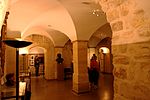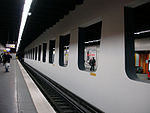Rue Montorgueil

Rue Montorgueil (French pronunciation: [ʁy mɔ̃tɔʁɡœj]) is a street in the 1st arrondissement and 2nd arrondissement (in the Montorgueil-Saint Denis-Les Halles district) of Paris, France. Lined with restaurants, cafés, bakeries, fish stores, cheese shops, wine shops, produce stands and flower shops, rue Montorgueil is a place for Parisians to socialize while doing their daily shopping. At the southernmost tip of rue Montorgueil is Saint-Eustache Church, and Les Halles, containing the largest indoor (mostly underground) shopping mall in central Paris; and to the north is the area known as the Grands Boulevards. While cars are not banned from the street, the priority is for pedestrians who can enjoy the cafes and shops while walking down the cobblestones.
Excerpt from the Wikipedia article Rue Montorgueil (License: CC BY-SA 3.0, Authors, Images).Rue Montorgueil
Rue Montorgueil, Paris 2nd Arrondissement (Paris)
Geographical coordinates (GPS) Address Nearby Places Show on map
Geographical coordinates (GPS)
| Latitude | Longitude |
|---|---|
| N 48.864944444444 ° | E 2.3468611111111 ° |
Address
Rue Montorgueil
75002 Paris, 2nd Arrondissement (Paris)
Ile-de-France, France
Open on Google Maps









